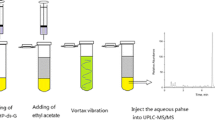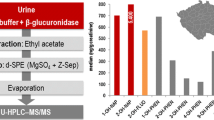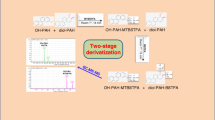Abstract
After environmental and occupational exposure to naphthalene, 1,2-dihydroxynaphthalene (1,2-DHN) was shown to be one major metabolite in human naphthalene metabolism. However, the instability of free 1,2-DHN complicates the reliable determination of this promising biomarker in urine. To solve this stability problem, glucuronide conjugates of 1,2-DHN and the corresponding isotopically labelled D6-1,2-dihydroxynaphthalene (D6-1,2-DHN) were synthesised and applied as reference material and internal standard in a gas chromatographic-tandem mass spectrometric (GC-MS/MS) method. The determination of 1- and 2-naphthol (1-MHN, 2-MHN) was included in the procedure to enable a comprehensive assessment of naphthalene metabolism and exposure. The results of the validation showed a high reliability and sensitivity of the method. The detection limits range from 0.05 to 0.16 μg/L. Precision and repeatability were determined to range from 1.4 to 6.6% for all parameters. The simultaneous determination of 1- and 2-MHN as additional parameters besides 1,2-DHN enables the application of the method for further metabolism and kinetic studies on naphthalene. The use of glucuronide-derivative reference substances and the application of structurally matched isotopic-labelled internal standards for each substance guarantee a reliable quantification of the main naphthalene metabolites 1,2-DHN and 1- and 2-MHN.

Reliable quantification of 1,2-dihydroxynaphthalene in urine using a conjugated reference compound for calibration





Similar content being viewed by others
References
Hartwig A (Ed). Naphthalene. The MAK-Collection for Occupational Health and Safety. Part I: MAK value documentations. 27th ed. Wiley-VCH: Weinheim; 2003.
Ziener C. Biomonitoring bei Naphthalinexponierten - ein Anwendungsbeispiel. Zbl Arbeitsmed. 2012;62:159–61.
Preuss R, Drexler H, Böttcher M, Wilhelm M, Brüning T, Angerer J. Current external and internal exposure to naphthalene of workers occupationally exposed to polycyclic aromatic hydrocarbons in different industries. Int Arch Occup Environ Health. 2005;78:355–62.
Elovaara E, Mikkola J, Mäkelä M, Paldanius B, Priha E. Assessment of soil remediation workers’ exposure to polycyclic aromatic hydrocarbons (PAH): biomonitoring of naphthols, phenanthrols, and 1-hydroxypyrene in urine. Toxicol Lett. 2006;162:158–63.
Gaudreau É, Bérubé R, Bienvenu J, Fleury N. Stability issues in the determination of 19 urinary (free and conjugated) monohydroxy polycyclic aromatic hydrocarbons. Anal Bioanal Chem. 2016;408:4021–33.
Li Z, Romanoff LC, Trinidad DA, Hussain N, Jones RS, Porter EN, et al. Measurement of urinary monohydroxy polycyclic aromatic hydrocarbons using automated liquid-liquid extraction and gas chromatography/isotope dilution high-resolution mass spectrometry. Anal Chem. 2006;78:5744–51.
Serdar B, Egeghy PP, Waidyanatha S, Gibson R, Rappaport SM. Urinary biomarkers of exposure to jet fuel (JP-8). Environ Health Perspect. 2003;111:1760–4.
Serdar B, Waidyanatha S, Zheng Y, Rappaport SM. Simultaneous determination of urinary 1- and 2-naphthols, 3- and 9-phenanthrols, and 1-pyrenol in coke oven workers. Biomarkers. 2003;8:93–109.
Yang M, Koga M, Katoh T, Kawamoto T. A study for the proper application of urinary naphthols, new biomarkers for airborne polycyclic aromatic hydrocarbons. Arch Environ Con Tox. 1991;36:99–108.
Preuss R, Koch HM, Wilhelm M, Pischetsrieder M, Angerer J. Pilot study on the naphthalene exposure of German adults and children by means of urinary 1- and 2-naphthol levels. Int J Hyg Envir Heal. 2004;207:441–5.
Ayala DC, Morin D, Buckpitt AR, Coulombe RA. Simultaneous quantification of multiple urinary naphthalene metabolites by liquid chromatography tandem mass spectrometry. PLoS One. 2015; https://doi.org/10.1371/journal.pone.0121937.
Bolton JL, Trush MA, Penning TM, Dryhurst G, Monks TJ. Role of quinones in toxicology. Chem Res Toxicol. 2000;13:135–60.
Buckpitt AR, Warren DL. Evidence for hepatic formation, export and covalent binding of reactive naphthalene metabolites in extrahepatic tissues in vivo. J Pharmacol Exp Ther. 1983;225:8–16.
Cho M. Reactive naphthalene metabolite binding to hemoglobin and albumin. Fundam Appl Toxicol. 1994;22:26–33.
Lau SS, Jones TW, Highet RJ, Hill BA, Monks TJ. Differences in the localization and extent of the renal proximal tubular necrosis caused by mercapturic acid and glutathione conjugates of 1,4-naphthoquinone and menadione. Toxicol Appl Pharm. 1990;104:334–50.
Lin C, Chen D, Wang S, Hsieh W, Yu W, Wang T, et al. Cumulative body burdens of polycyclic aromatic hydrocarbons associated with estrogen bioactivation in pregnant women: protein adducts as biomarkers of exposure. J Environ Sci Heal A. 2014;49:634–40.
Murty VS, Penning TM. Polycyclic aromatic hydrocarbon (PAH) ortho-quinone conjugate chemistry: kinetics of thiol addition to PAH ortho-quinones and structures of thioether adducts of naphthalene-1,2-dione. Chem Biol Interact. 1992;84:169–88.
Troester MA. Stability of hemoglobin and albumin adducts of naphthalene oxide, 1,2-naphthoquinone, and 1,4-naphthoquinone. Toxicol Sci. 2002;68:314–21.
Tsuruda LS, Lamé MW, Jones AD. Formation of epoxide and quinone protein adducts in B6C3F1 mice treated with naphthalene, sulfate conjugate of 1,4-dihydroxynaphthalene and 1,4-naphthoquinone. Arch Toxicol. 1995;69:362–7.
Waidyanatha S, Troester MA, Lindstrom AB, Rappaport SM. Measurement of hemoglobin and albumin adducts of naphthalene-1,2-oxide, 1,2-naphthoquinone and 1,4-naphthoquinone after administration of naphthalene to F344 rats. Chem Biol Interact. 2002;141:189–210.
Waidyanatha S, Zheng Y, Serdar B, Rappaport SM. Albumin adducts of naphthalene metabolites as biomarkers of exposure to polycyclic aromatic hydrocarbons. Cancer Epidem Biomar. 2004;13:117–24.
Zheng J, Cho M, Jones AD, Hammock BD. Evidence of quinone metabolites of naphthalene covalently bound to sulfur nucleophiles of proteins of murine Clara cells after exposure to naphthalene. Chem Res Toxicol. 1997;10:1008–14.
Klotz K, Schindler BK, Angerer J. 1,2-Dihydroxynaphthalene as biomarker for a naphthalene exposure in humans. Int J Hyg Envir Heal. 2011;214:110–4.
Wu R, Waidyanatha S, Henderson AP, Serdar B, Zheng Y, Rappaport SM. Determination of dihydroxynaphthalenes in human urine by gas chromatography–mass spectrometry. J Chromatogr B. 2005;826:206–13.
Hayes JA, Eccles KS, Lawrence SE, Moynihan HA. Preparation and characterisation of solid state forms of paracetamol-O-glucuronide. Carbohydr Res. 2012;349:108–12.
Magdziak D, Rodriguez AA, Van De Water RW, Pettus TRR. Regioselective oxidation of phenols to o-quinones with o-iodoxybenzoic acid (IBX). Org Lett. 2002;4:285–8.
Pezzella A, Lista L, Napolitano A, d’Ischia M. An expedient one-pot entry to catecholestrogens and other catechol compounds via IBX-mediated phenolic oxygenation. Tetrahedron Lett. 2005;46:3541–4.
DIN 32645. Chemical analysis—decision limit, detection limit and determination limit under repeatability conditions—terms, methods, evaluation. Berlin: Beuth; 2008.
World Health Organization (WHO). Biological monitoring of chemical exposure in the workplace: guidelines, vol. 96. Geneva: WHO/HPR/OCH; 1996. p. 1.
Göen T, Schaller K, Drexler H. External quality assessment of human biomonitoring in the range of environmental exposure levels. Int J Hyg Envir Heal. 2012;215:229–32.
Romanoff LC, Li Z, Young KJ, Blakely NC, Patterson DG, Sandau CD. Automated solid-phase extraction method for measuring urinary polycyclic aromatic hydrocarbon metabolites in human biomonitoring using isotope-dilution gas chromatography high-resolution mass spectrometry. J Chromatogr B. 2006;835:47–54.
Kumagai S, Matsunaga I. Concentrations of urinary metabolites in workers exposed to monochlorobenzene and variation in the concentration during a workshift. Occup Environ Med. 1994;51:120–4.
Schmidt L, Göen T. Simultaneous determination of the full chlorophenol spectrum in human urine using gas chromatography with tandem mass spectrometry. Anal Chim Acta. 2017;965:123–30.
Schmidt L, Müller J, Göen T. Simultaneous monitoring of seven phenolic metabolites of endocrine disrupting compounds (EDC) in human urine using gas chromatography with tandem mass spectrometry. Anal Bioanal Chem. 2013;405:2019–29.
Buckpitt A, Boland B, Isbell M, Morin D, Shultz M, Baldwin R, et al. Naphthalene-induced respiratory tract toxicity: metabolic mechanisms of toxicity. Drug Metab Rev. 2002;34:791–820.
Preuss R, Angerer J, Drexler H. Naphthalene—an environmental and occupational toxicant. Int Arch Occup Environ Health. 2003;76:556–76.
Acknowledgements
We thank the German Federal Institute for Occupational Safety and Health (Bundesanstalt für Arbeitsschutz und Arbeitsmedizin) for the kindly provision of urine samples of exposed employees.
We are grateful to J. Bienert (MPI bpc) for recording 1H-NMR and mass-spectra and to Dr. H. Frauendorf and his co-workers (Institute of Organic and Biomolecular Chemistry, Georg-August-University Göttingen) for HR-MS (ESI) of 1,2-DHN-Glc and D6-1,2-DHN-Glc.
Author information
Authors and Affiliations
Corresponding author
Ethics declarations
Conflict of interest
The authors declare to have no conflict of interests.
Human and animal rights and informed consent
Sample collection of workers urine was approved by the local ethics committee of the University of Erlangen-Nürnberg (Re.-No. 3997, 13.05.2009). Informed consent was obtained from all sample donors and they provided their urine voluntarily. No identifying information is included in this article.
Electronic supplementary material
ESM 1
(PDF 899 kb)
Rights and permissions
About this article
Cite this article
Zobel, M., Göen, T., Belov, V. et al. Reliable quantification of 1,2-dihydroxynaphthalene in urine using a conjugated reference compound for calibration. Anal Bioanal Chem 409, 6861–6872 (2017). https://doi.org/10.1007/s00216-017-0651-9
Received:
Revised:
Accepted:
Published:
Issue Date:
DOI: https://doi.org/10.1007/s00216-017-0651-9




